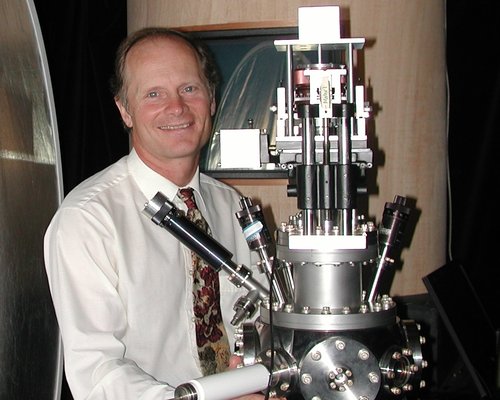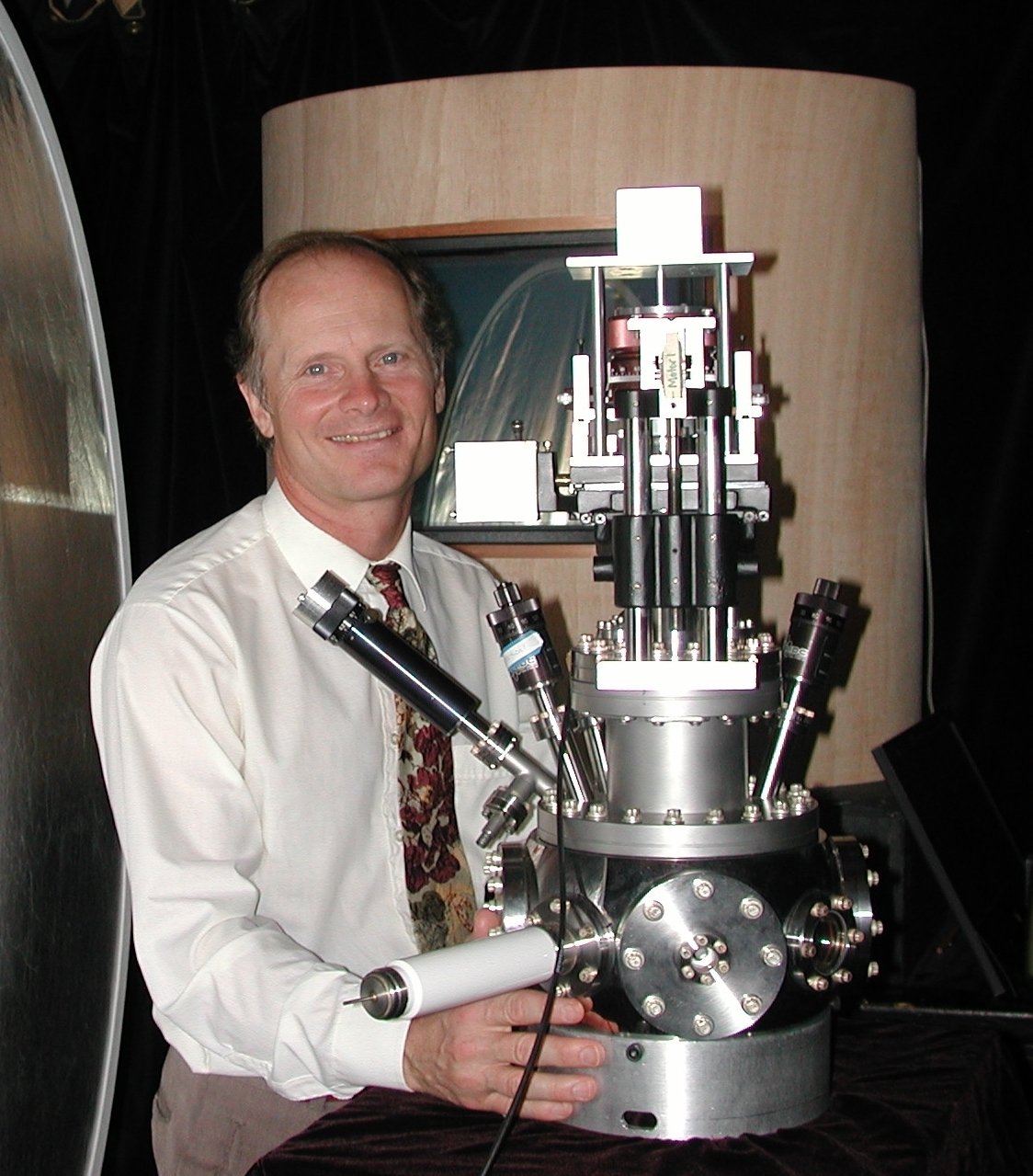Femtosecond Electron Diffraction (FED) has availed atomic resolution of structural changes as they occur, essentially watching atoms move in real time. It combines temporal resolution on the hundred femtosecond (fs) time scale – a time scale typically only accessible by time-resolved optical spectroscopy – with real-space structural information on the atomic scale.
The visualization of atomic motions has long been used as a gedanken experiment to develop a conceptual basis for various phenomena. One can look to the typical transition states or proposals of reactive intermediates in organic chemistry as classic examples of this thought experiment. Similar examples can be found in biology in pondering how protein structure affects transition states at active sites, unwinding of DNA etc. Within physics, there are numerous examples from Coulomb explosions to atomic displacements involved in phase transitions and phonon propagation. This class of thought experiment has long been considered out of the realm of experiment. With the recent development of femtosecond electron pulse sources with sufficient number density to execute nearly single-shot structure determinations, this experiment was realized by atomically resolving laser driven phase transitions (see Siwick et al Science 2003, in particular Figure 1). These first grainy frames are very similar to the early Daguerreotypes in photography. It was the first time to capture sufficient diffraction orders to fully resolve the structural changes at the atomic level of detail – faster than collisions blur out the relative atomic motions. One could literally watch the onset of the liquid state with the key motions involving shear or transverse motions. One of the definitions for the onset of the liquid state is the inability to support shear motions, with the rms motions exceeding the transverse barrier and here we see these motions directly.
"R. J. Dwayne Miller with his baby - the first molecular movie camera, which achieved subpicosecond time resolution to observe atomic motions faster than collisions blurring out details of relative atomic motions."


The First Atomic Movies – A Personal Account (RJDM). This first atomically resolved depiction of a structural transition (or “molecular movie”) was even more interesting that it may seem at first glance. Melting was driven under rather special boundary conditions involved with strongly driven phase transitions. The particular question being addressed by this work dates back to a long standing debate in the 1930’s concerning the onset of the liquid state under extreme pressures and temperatures (see Miller Science 2014 for a historical account). This issue also has ramifications for understanding the state of matter in other extreme conditions such as the interior of planets or stars. To put this question in proper context, consider the melting of a block of ice. We all know ice melts from the surface in a process referred to as heterogeneous nucleation. We also know that if we direct a blow torch to the ice it will melt faster. What if you could heat up the ice so fast that based on extrapolations of heating rates and melt velocities, you would predict the system should melt faster than the atoms could move (or more correctly faster than the speed of sound)? Now, that is an interesting question.
The answer can be gleaned from this data directly without a high level of analysis (see Siwick et al Science 2003, Figure 1). The experiment used a special “blow torch”, in this case a femtosecond laser system, to achieve heating rates approaching 1015 K/s. At 500 fs, you can see high order diffraction rings illustrating that the Al is still in its nascent face centered cubic (FCC) lattice. At 1.5 ps, you can see these rings become dimmer as the initially photoexcited electrons lose energy to lattice phonons. The increase in rms motion of the atoms reduces the lattice coherence and corresponding diffraction as described by temperature dependent Debye-Waller factors. The most astonishing event happens between 2.5 ps and 3.5 ps. There is an incredibly fast lattice collapse in which covalent bonds are broken and the face centered cubic coordination number goes from 12 to an ensemble average of 10 for the unstructured shell like structure of a liquid. Once reaching the critical point for this degree of superheating, the whole melting process occurred within 1 ps. This time scale has to be fully appreciated. This is 10 times faster than this process could occur through normal heterogeneous nucleation. The melting process was literally occurring faster than the speed of sound for heterogeneous nucleation. Rather than melting from the surface in an “outside-in” fashion (heterogeneous nucleation), the system was melting from the “inside-out”. This was the first atomic view of the long predicted process of homogeneous nucleation. From the real space transform, it was possible to discern that the largest changes involve shear atomic motions with the collapse of the transverse barrier as part of forming the liquid state. As a physical chemist, this was a very gratifying observation as the importance of shear type motions in formation of the liquid state is a key concept taught to understand nucleation growth and phase transitions. Now we can see this process directly at the atomic level.
Most important, these observations showed how to control nucleation growth to as few as 10 atoms and avoid cavitation induced shock waves and thermal damage in laser driven ablation. Based on this new insight, a picosecond IR laser tuned to the OH stretch of water in tissue was developed for laser surgery with the correct temporal profile to restrict nucleation growth. This method has now been shown to be capable of cutting tissue without scar tissue formation, or ionizing radiation effects, and as an added bonus to give fully intact protein signatures of tissue. The big surprise was the lack of excessive fibroblast formation that leads to scar tissue formation (see Amini-Nik et al PLoS 2010). The importance of this development can be readily appreciated. In this respect, the promise of the laser for achieving the fundamental (cellular) limit to minimally invasive surgery has now been achieved with a number of promising applications identified. Generally it is difficult to trace the thread from basic science to societal benefits. Here the connection is clear.
Our initial work in this area primarily focused on photoinduced phase transitions (see Ernstorfer et al Science 2009, Harb et al Phys. Rev. Lett. 2008, Sciaini et al Nature 2009, Eichberger et al Nature 2010 etc.). One has to appreciate that on the femtosecond time scale of the photoexcitation process, the lattice is effectively frozen. The optical transition to a higher lying electronic state instantaneously changes the electron distribution relative to the time scale of nuclear motions. We now have a unique opportunity to directly observe the effects of changes in electron distribution and electron correlation energies on bonding, or the many body potential defining the bound state, by observing the atomic motions in response to these changes. The observation of structural transitions at this fundamental space-time limit in terms of following the nuclear coordinate have led to new insights - and in many cases surprises. These studies include strongly driven phase transitions involved in nonthermal melting or electronically driven nucleation effects, to creating states of warm dense matter with a counterintuitive apparent increase in bond strengths (so called bond hardening) at high excitation levels, to the direct observation of highly cooperative many body physics - to the extent of providing coherent responses to weak perturbations of strongly correlated electron-lattice systems. With respect to the latter case, the highest quality atomic movies of structural transitions have in fact been observed in layered compounds that exhibit interesting 2D effects on electron correlation energies and bonding (see Eichberger et al Nature 2010). Charge Density Waves (CDW) are examples in which small modulation in plane leads to larger wavefunction overlap in the plane and to higher overall lattice stability. By photoinducing a change in charge distribution, this delicate balance in forces between intra and interplane coupling is modified and the lattice relaxes to a higher symmetry state. The best example of this is the movie of the photoinduced suppression of the CDW modulation in TaS2 where one can observe a very dramatic effect in which both the suppression and reformation of the CDW occur at the fundamentally fastest possible speeds. This work has been extended to other related systems such as TaSe2 where one observes similar effects however with very interesting differences due to different inter-plane couplings (see Miller Science 2014 for full references to important related work and to put the above into proper historical context). When one observes such a collective effect at the atomic level, there is an immediate appreciation of the highly cooperative nature of strongly correlated electron-lattice systems. The visual connection to the many body effects helps to drive home the operating physics in a single measurement. Effectively, it is a direct observation of the electron-lattice coupling. These observations should then provide rigorous benchmarks for high level theory that together will help advance our understanding and control of the novel properties of strongly correlated electron-lattice materials.
From a chemistry perspective, the real power of high bunch charge (brightness) electron sources has been recently demonstrated using femtosecond crystallography to follow the photoinduced reaction dynamics of organic systems, the mainstay of chemistry. This class of materials invariably has low thermal conductivities and involves large amplitude motions as part of the reaction dynamics. Both effects conspire to greatly limit the sampling rate and number of photocyles. In addition, organic systems have much more complex structures than the solid state systems with simple unit cells discussed above. Further improvements in source brightness were essential to open up the study of organic systems. In what could be considered to be the first truly molecular movie, an extension of rf pulse compression methods enabled the capture of the photoinduced structural changes in the interesting organic system EDO-TTF (see Gao et al Nature 2013).
Another example of our femtosecond electron diffraction capabilities was demonstrated in observing the ring-closing reaction in diarylethene (see Jean-Ruel et al, J. Phys. Chem., 2013). This represents the first molecular movie of a molecular reaction. It is most noteworthy that this work involved the formation of chemical bond in the process of electrocyclization with conserved stereochemistry. This reaction is something routinely exploited by synthetic chemists. These studies lit up the key reaction modes and demonstrated the collapse of over 50 possible modes (dimensions defining all possible nuclear configurations) to just 4 key reaction modes. The secret to general reaction mechanisms was directly observable. A 3D model of the experimental target is shown below.
These two examples are just a subset of a growing list of chemical reactions that can now be resolved at the atomic level where it is now clear that this reduction in dimensionality to a few key reaction modes is a general phenomenon. This statement could have been deduced from the empirical discovery of generalized reaction mechanisms over time. However, we now can see the specific modes involved and can discern the underlying physics is related to the anharmonic coupling of high and low frequency modes leading to localized motions aka reaction modes. We also can not correlate these modes to the evolving change in electron distribution that creates the reaction forces directing the chemistry.
In addition to the above video on Ring-closing, the 3D model of Diarylethene below allows you to rotate the model and change the size of model.

